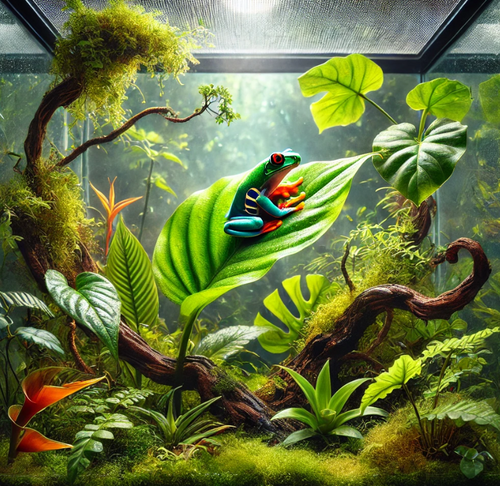Enhancing a Tropical Frog Enclosure: Creating the Perfect Habitat for Your Amphibian Friends
Posted by BioSupplies on 5th Jul 2024
Tropical frogs, with their vibrant colors and fascinating behaviors, make captivating pets. To ensure they thrive, it's essential to create an enclosure that mimics their natural rainforest habitat. Here’s how to set up and enhance a tropical frog enclosure for species like the Red-Eyed Tree Frog and Green Tree Frogs.
Understanding the Tropical Frog’s Natural Habitat
Tropical frogs require high humidity, moderate to high temperatures, and plenty of vegetation. They thrive in environments that replicate the warm, moist conditions of the rainforest.
Setting Up the Basics
- Tank Size and Type
- Size: A 40 litre tank is suitable for smaller tropical frogs, but larger species or multiple frogs will need a 75 litre or larger tank.
- Material: Glass tanks are ideal due to their visibility and ability to maintain humidity. Ensure the tank has a secure lid to prevent escapes.
- Substrate
- Use substrates like coconut fiber, sphagnum moss, or a mixture of soil and leaf litter. These materials retain moisture well and mimic the natural forest floor.
- Heating and Lighting
- Temperature: Maintain a temperature range of 24-29°C using heat lamps or under-tank heaters.
- Lighting: Provide a day/night cycle with UVB lighting, essential for frogs like common green tree frogs to synthesize vitamin D3 and absorb calcium.
- Humidity Control
- Install a hygrometer to monitor humidity levels. Tropical frogs need humidity levels between 70-90%.
- Use a misting system, fogger, or manual misting to maintain proper humidity. A water dish or small water feature can also help increase humidity.
Enclosure Design and Enrichment
- Plants and Foliage
- Use live or artificial plants to create a lush environment. Live plants help maintain humidity and provide hiding spots. Suitable plants include pothos, bromeliads, ferns, and mosses.
- Hides and Climbing Structures
- Provide hiding spots using cork bark, hollow logs, or commercially available hides. Include branches, vines, and other climbing structures for arboreal species.
- Water Features
- Include a water area with clean, dechlorinated water. Use a filter to keep the water clean and change it regularly.
- Feeding Stations
- Create designated feeding areas for live food such as crickets, mealworms, or flies. This helps keep the enclosure clean and allows you to monitor your frog's feeding habits.
- Regular Maintenance
- Clean the enclosure regularly to prevent mold, bacteria, and waste buildup. Spot clean daily and perform a deep clean every few weeks.
Observing and Interacting with Your Frogs
- Behavioral Observation
- Spend time observing your frogs to understand their behaviors and preferences. This can help you make necessary adjustments to their environment.
- Handling
- Minimize handling to reduce stress. When necessary, handle frogs with clean, wet hands to avoid transferring harmful substances.
- Health Monitoring
- Keep an eye on your frog’s health, looking out for signs of illness such as changes in appetite, skin discoloration, or lethargy. Consult a veterinarian experienced with amphibians if you notice any concerning symptoms.
By understanding and replicating the natural habitat of tropical frogs, you can create an enriching and comfortable environment that promotes their health and happiness.

